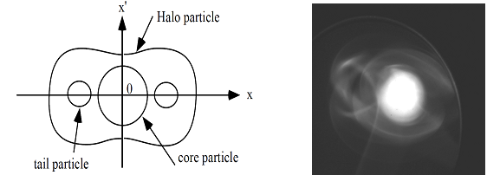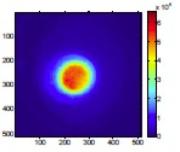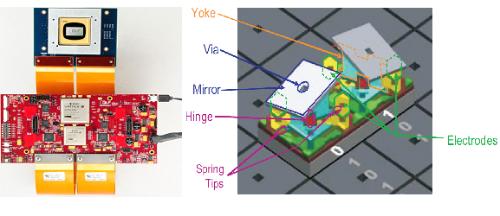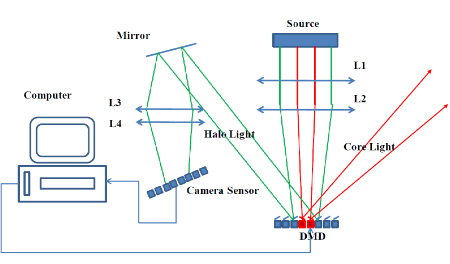Beam Halo Monitoring
A major challenge in any high intensity accelerator is the detection and control of beam halo within the close proximity of the very dense beam core to the slightly populated halo. This is a key parameter to understand in order to minimize the number of particles in the tail region of the beam distribution. The beam halo is undesirable as it is associated with many bad effects, as these unwanted particle losses lead to an activation or even damage of the surrounding vacuum chamber.

A novel beam halo monitor with a high dynamic range is required to ensure that halo particles can be monitored with sufficient accuracy. This observational technique uses special camera technology to allow for high dynamic range (DR) measurements when monitoring light generated by the beam, either through Synchrotron Radiation, Optical Transition Radiation or luminescent screens. Different optical methods of achieving the high dynamic range requirements are currently under investigation in the QUASAR-group.
 The main idea of this research is to allow investigations into halo propagation and formation processes directly in an accelerator. The method developed to image beam halo is a new adaptive masking method, which uses the most advance high-definition digital micro-mirror-array device (HD DMD) that is capable of measuring transverse profiles with a dynamic range (DR) of better than, DR >10e5.
The main idea of this research is to allow investigations into halo propagation and formation processes directly in an accelerator. The method developed to image beam halo is a new adaptive masking method, which uses the most advance high-definition digital micro-mirror-array device (HD DMD) that is capable of measuring transverse profiles with a dynamic range (DR) of better than, DR >10e5.

The digital micro-mirror-array device (DMD) is used to generate a core blocking mask that is defined by establishing an intensity threshold, the light from the particle beam core can be reflected away from the optical path to the camera so that the rest of the profile, i.e. the wings or ‘halo’ of the distribution can be measured.

The monitor has demonstrated its capability for measuring the transverse profile of a beam of charged particles with a dynamic range of better than >10e5 in both laboratory studies and in experiments with beam.

The DMD is favourable for applications with high DR and acquisition rate requirements. This device is inexpensive technology with a flexible core masking technique. The core masking technique is well known from astronomy where masks are used to mask out the central part of the sun to observe its corona. But unlike astronomical objects, an accelerator beam is not constant in time. Therefore, a fixed mask will not suffice, but a flexible mask is required. The achievable dynamic range depends on the chosen size of the mask.
By this new combination of optimizations into the optical imaging system, it will be capable of providing even higher frame rates and better spatial resolution, and be a tool in benchmarking the results with different laboratory studies or in experiments beams.
Watch the Video: Beam Halo Monitoring
Currently involved QUASARs:
Selected publications:
B.B.D. Lomberg, C.P. Welsch, 'Beam Halo Monitor based on an HD Digital Micro Mirror Array', Proc. IBIC 2013, Oxford, UK (2013)
R. Fiorito, A. Shkvarunets and H. Zhang, D. Douglas, F. Wilson and S. Zhang, J. Corbett, A. Fisher, W. Mok and K. Tian, T. Mitsuhashi, 'Optical Synchrotron Radiation Beam Imaging with a Digital Mask', Proc. BIW, Newport News, Virginia, USA (2012)
H. D. Zhang, R. B. Fiorito, A. G. Shkvarunets, and R. A. Kishek, 'Beam halo imaging with a digital optical mask', Phys. Rev. ST Accel. Beams 15, 072803 (2012)
H. Zhang, B. Beaudoin, S. Bernal, R. Fiorito, R. Kishek, K. Poor Rezaei, A. Shkvarunets, 'Beam Halo Measurements using Adaptive Masking Methods and Proposed Halo Experiment', 52nd ICFA Advanced Beam Dynamics Workshop on High-Intensity and High-Brightness Hadron Beams (2012)
H. D. Zhang, R. B. Fiorito, A. Shkvarunets, R. A. Kishek, S. Bernal, P. G. O'Shea, 'Beam Halo Measurements at UMER and the JLAB FEL using an Adaptive Masking Method', Proc. PAC, New York, USA (2011)
J. Egberts, C.P. Welsch, 'Flexible core masking technique for beam halo measurements with high dynamic range', JINST 5 P04010, doi: 10.1088/1748-0221/5/04/P04010
C.P. Welsch, S. Artikova, R. Fiorito, A. Shkvarunets, H. Zhang, 'Beam Halo Studies for CTF3', Proc. IPAC, Kyoto, Japan (2010)
R. Fiorito, S. Bernal, I. Haber, R. Kishek, P. O'Shea, A. Shkvarunets, H. Zhang, S. Artikova, C.P. Welsch, 'Beam Halo Imaging with an Adaptive Optical Mask', Proc. BIW, Santa Fe, NM, USA (2010)
J. Egberts, S. Artikova, C.P. Welsch, 'Flexible Core Masking Technique for Beam Halo Measurements with High Dynamic Range', Proc. DIPAC Workshop, Basel, Switzerland (2009)
C.P. Welsch, E. Bravin, T. Lefèvre, 'A Beam Halo Monitor Based on Adaptive Optics', Proc. SPIE Europe Optical Metrology, Munich, Germany (2007)
C.P. Welsch, E. Bravin, B. Burel, T. Lefèvre, T. Chapman, M. Pilon, 'High Dynamic Range Beam Profile Measurements', Proc. Europ. Part. Acc. Conf., Edinburgh, Scotland (2006), CERN-AB-2006-068, CLIC note 686 and CTF3 note 081
C.P. Welsch, E. Bravin, B. Burel, T. Chapman, T. Lefèvre, M.J. Pilon, 'Alternative Techniques for Beam Halo Measurements', Meas. Sci. Technol. 17 (2006) 2035c, CERNAB- 2006-23